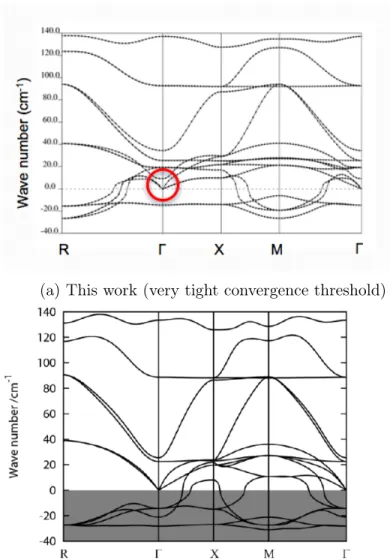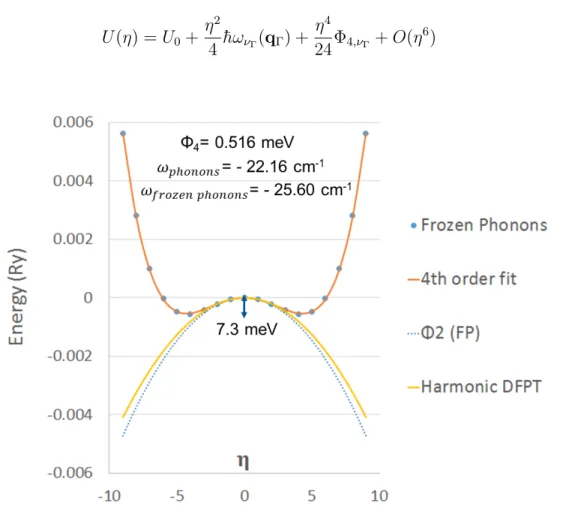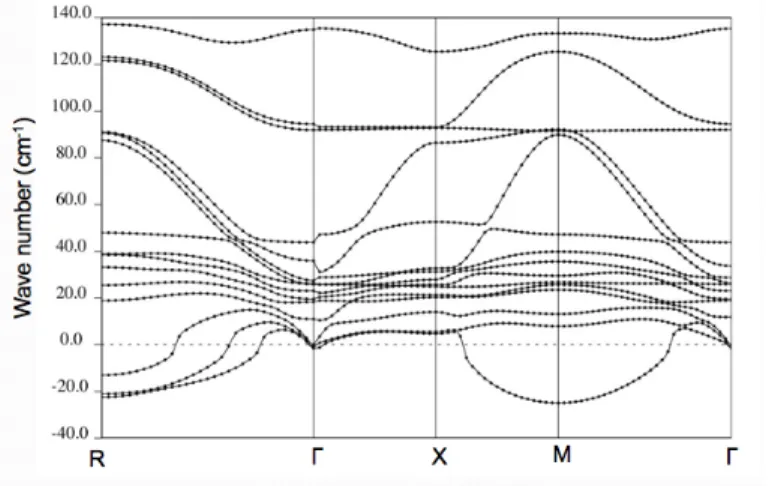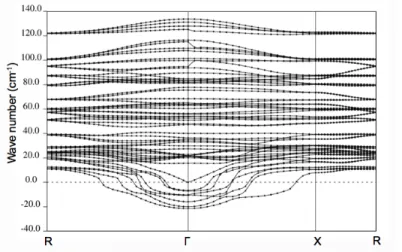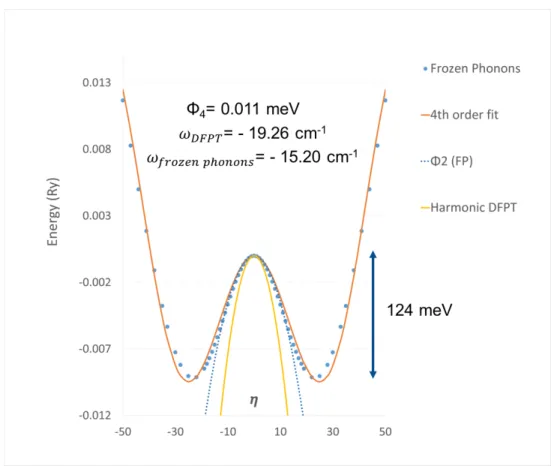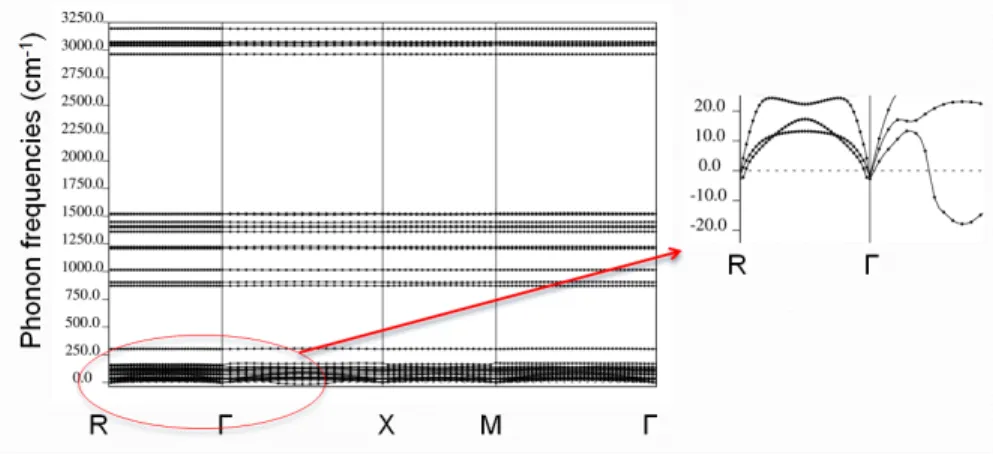HAL Id: hal-01528877
https://hal.archives-ouvertes.fr/hal-01528877
Submitted on 13 Dec 2018HAL is a multi-disciplinary open access
archive for the deposit and dissemination of sci-entific research documents, whether they are pub-lished or not. The documents may come from teaching and research institutions in France or abroad, or from public or private research centers.
L’archive ouverte pluridisciplinaire HAL, est destinée au dépôt et à la diffusion de documents scientifiques de niveau recherche, publiés ou non, émanant des établissements d’enseignement et de recherche français ou étrangers, des laboratoires publics ou privés.
Structural Instabilities Related to Highly Anharmonic
Phonons in Halide Perovskites
Arthur Marronnier, Heejae Lee, Bernard Geffroy, Jacky Even, Yvan
Bonnassieux, Guido Roma
To cite this version:
Arthur Marronnier, Heejae Lee, Bernard Geffroy, Jacky Even, Yvan Bonnassieux, et al.. Structural Instabilities Related to Highly Anharmonic Phonons in Halide Perovskites. Journal of Physical Chem-istry Letters, American Chemical Society, 2017, 8 (12), pp.2659-2665. �10.1021/acs.jpclett.7b00807�. �hal-01528877�
Structural Instabilities related to Highly
Anharmonic Phonons in Halide Perovskites
Arthur Marronnier,
†Heejae Lee,
†Bernard Geffroy,
†,§Jacky Even,
‡Yvan
Bonnassieux,
†and Guido Roma
∗,¶†LPICM, CNRS, Ecole Polytechnique, Université Paris-Saclay, 91128 Palaiseau, France ‡Université Européenne de Bretagne, INSA, FOTON, UMR 6082, 35708 Rennes, France ¶DEN - Service de Recherches de Métallurgie Physique, CEA, Université Paris-Saclay,
91191 Gif sur Yvette, France
§LICSEN, NIMBE, CEA, CNRS, Université Paris-Saclay, 91191 Gif sur Yvette, France E-mail: arthur.marronnier@polytechnique.edu
Abstract
Hybrid organic-inorganic perovskites have emerged over the past five years as ab-sorber layers for novel high-efficiency low-cost solar cells that combine the advantages of organic and inorganic semiconductors. Unfortunately, the physics behind the electronic transport in these materials is still poorly understood. Here, employing the linear re-sponse approach of Density Functional Theory, we reveal strong anharmonic effects in inorganic CsP bI3 and a double-well phonon instability at the center of the Brillouin zone for both cubic and orthorhombic phases. Factoring these low-energy phonons into electron-phonon interactions and band gap calculations could help better understand the electrical transport properties in perovskites. Furthermore, previously reported soft phonon modes are here stabilized at the actual lower-symmetry equilibrium structure, which occur in a very flat energy landscape, highlighting the strong competition between the different phases of CsP bI3. The perovskite oscillations through the corresponding energy barrier could explain the underlying ferroelectricity and the dynamical Rashba effect predicted in halide perovskites for photovoltaics.
Hybrid Perovskite Solar Cells (PSCs), a new generation of solar cells which combines the advantages of organic and inorganic semiconductors, were born only a few years ago after perovskites were used as absorbing materials in dye-sensitized solar cells (DSCs).1 After a
mere 6 years of research, the efficiency of PSCs has jumped from 4% in 2009 to certified efficiencies over 20%2 in 2015 and a record efficiency of 22.1%3 in 2016, becoming the first
truly low-cost and highly efficient generation of solar cells.
Researchers started phonon calculations of hybrid M AP bI3 perovskites as early as 2013,
when Quarti et al.4 measured its Raman spectrum, assisted by Density Functional Theory (DFT) calculations which showed the importance of the torsional mode of the methylammo-nium cations as a marker of the orientational disorder of the material. As shown by various groups since then,5–7 this picture is further complicated by the reorientational dynamics of
the organic component similar to what is usually observed in plastic crystals, since quasielas-tic neutron scattering measurements showed that dipolar CH3N H3+ions reorientate between
the faces quite rapidly. Very recently, Whalley et al.8 and Beecher et al.9 found double-well instabilities present at the Brillouin Zone (BZ) boundary of M AP bI3, much like what we
report here in the CsP bI3 case, as well as short phonon quasiparticle lifetimes and mean free
paths. However, contrary to our findings for CsP bI3, they did not find any instabilities at
the center of the BZ for M AP bI3. These structural effects in organohalide perovskites were
studied in detail by Amat et al.10who showed that the interplay of spin-orbit coupling (SOC)
and octahedra tilting can have a strong impact on their electronic and optical properties, including the band gap.
It is only in the past two years that inorganic (mostly cesium-based) perovskites for photo-voltaics have attracted more and more attention from the PSC community after being incor-porated into complex but more stable mixed-halide mixed-cation perovskite structures (such as [HC(N H2)2]0.83Cs0.17P b(I0.6Br0.4)3) demonstrating the feasibility of achieving above 25%
efficiency four-terminal tandem cells11 at the beginning of 2016.
have been studied in detail using ab-initio calculations. Lora da Silva et al. employed12 the quasiharmonic approximation to study the temperature-dependent lattice dynamics of the four different phases of cesium tin iodide. Patrick et al. reported13 strong anharmonic
effects in CsSnI3 (including soft phonon modes) using self-consistent phonon theory and
frozen phonons, and showed that these soft modes were stabilized at experimental conditions through anharmonic phonon-phonon interactions between the Cs ions and their iodine cages. They further calculated the renormalization of the band gap due to vibrations. These two works demonstrate the important role of temperature in accurately analysing anharmonic perovskite materials like CsSnI3.
The role of phonons in the phase transitions of perovskites containing lead and cesium was recognized long ago (e.g. CsP bCl314). This suggests that vibrational properties could
control the structural transitions also for CsP bI3, which is crucially important for most
recent PSCs.
The vibrational properties of inorganic CsP bI3 perovskites have not been extensively
studied so far. Stoumpos et al. studied the dependence of CsP bI3’s band gap on
tempera-ture and the reversibility of its phase changes from non-perovskite structempera-tures to perovskite structures at high temperature. They showed15 that the room temperature stable δ-phase
(yellow) converts to the black perovskite α-phase upon heating above 360 ◦C. On cooling, the perovskite structure converts to the black perovskite β- and γ-phases at 260 and 175◦C, respectively. After a few days, a full recovery of the initial δ-phase is observed. A prediction of possible structural instabilities in CsP bI3 and RbP bI3 perovskite was made, on the basis
of relatively high values of the Born effective charges, by Brgoch and co-workers16 ; but to the best of our knowledge it has remained a speculation until we present our results here.
In this paper, we study the vibrational properties of both the high-temperature cubic α-phase and the orthorhombic δ-phase of CsP bI3, and compare them to the phonons of
M AP bI3’s cubic phase. For both phases, phonon spectra, derived using the linear approach
the existence of instabilities which we investigated in detail using total energy calculations along the corresponding phonon eigenvectors (frozen phonons framework). More information about the DFT and DFPT calculations can be found in the Computational Methods section at the end of the paper. Additional calculations on the influence of spin-orbit coupling on these results are also detailed in the Supporting Information file.
The phonon dispersion relations of inorganic perovskite CsP bI3 in the cubic high
tem-perature α-phase, with commonly accepted space group P m3m,17 are reported in figure 1a. The presence of soft modes at different high-symmetry points in the Brillouin zone can be explained by the fact that the α-phase is stable only at high temperature, where both energetic and entropic contributions determine the free energy F, and not at the (zero) tem-perature of DFT calculations. In principle, these modes are stabilized by taking into account temperature, i.e., the vibrational entropy and its contribution to the free energy.
What is more surprising is the presence of imaginary modes at the Γ-point (one triply degenerated mode at -15 cm−1), where one expects to find acoustic modes, linearly going to zero at Γ, as the lowest frequency modes. These instabilities and in particular this anomaly at Γ for the cubic phase of CsP bI3 have already been reported by Kawai et al.18 (see figure
1b), but they offered no explanation or further analysis.
As circled in red on figure 1a, the Acoustic Sum Rule (ASR) was imposed in our calcu-lations through post-processing of the dynamical matrix to ensure translational invariance. The ASR did bring back to zero the three-fold degenerated acoustic branches at the Γ-point but did not affect the soft mode, confirming its nature as an optical mode. We analyzed the dynamical matrix’s eigenvector corresponding to this soft mode, and its anti-symmetrical characteristics (see figure 2) are consistent with the irreducible representations of the P m3m symmetry group as reported by Even et al.7
The soft modes obtained here are coherent with previous neutron scattering measure-ments clearly indicating that the energy of the whole acoustic phonon density of states is remarkably low at 80◦C.7 In particular, it was shown for CsP bCl
acous-(a) This work (very tight convergence threshold)
(b) Results from Kawai et al., reprinted with permission from18 (copyright 2015 American Chemical Society)
Figure 1: Phonon modes of cubic CsP bI3.
Figure 2: Displacement eigenvector corresponding to the soft phonon mode found at Γ for cubic CsP bI3. Its irreducible representation is the infrared-active Γ−4 representation. The
tic (TA) branches always stay under 2 meV (16 cm−1)14 and that the optical phonons close to the R and M points also lie in the same energy range (< 2 meV). Here, our calculations show instabilities of the same order of magnitude (around 20 cm−1) coming from optical modes close to the M point (see figure 1a). Similar conclusions were drawn more recently for CH3N H3P bI39 and CH3N H3P bBr3.19
We think that these instabilities indicate strong anharmonic effects (also confirmed by the unusually large Debye-Waller factors measured previously for M AP bX3 compounds7,20)
and a very flat energy profile around equilibrium in CsP bI3. This very flat profile could affect
the reported low-to-negative frequency values in two ways: (i) by affecting the evaluation of the frequency values itself (due to numerical noise), and (ii) by preventing the structural relaxation algorithm to find the ground state structure. In order to assess these two hy-potheses, we first (i) used smaller and smaller DFPT convergence thresholds and second (ii) performed frozen phonon calculations to investigate anharmonicity up to the fourth order.
The use of very tight thresholds for total energy convergence, forces during relaxations, and self-consistency of the linear response calculations (see Computational Methods sec-tion) reduced the number of imaginary phonons at Γ, but one triply degenerated soft mode remained (see figure 1a), compared to 5 as published by Kawai et al.18 (figure 1b).
Unfortunately the most widely-used approach to go further than the harmonic approxi-mation and to calculate the free energy F by adding a volume (thus temperature) dependent vibrational free energy, the quasi-harmonic approximation,21 cannot be straightforwardly
applied12 due to the presence of these unstable phonon modes. Another technique is to guess the unstable directions using phonon eigenvectors obtained with the linear response approach of DFT. Here, we computed frozen phonon-perturbed total energies for the soft optical mode at Γ. A displacement of the form:
uκ(η) = η · xκνΓ(qΓ) (1)
the unitless displacement parameter η, where x is the chosen soft mode eigenvector obtained from harmonic DFPT phonon calculations.
Using Laudau theory22 and the adiabatic approximation, which assumes the electronic
system instantaneously changes after new ionic positions are reached, the anharmonic en-ergy14,23 as a function of displacement is given by:
U (η) = U0+ η2 4hω¯ νΓ(qΓ) + η4 24Φ4,νΓ+ O(η 6 ) (2)
Figure 3: Potential-energy surface from frozen phonon calculations of cubic CsP bI3 along
the eigenvector of the unstable optical phonon at Γ as a function of displacement parameter η. The 3N dimensional displacement needed to reach the new minimum corresponds to around 0.43 ˚A. ωf rozenphonons and Φ4 are obtained by fitting equation 2. As expected, the
results show good agreement between frozen phonon and DFPT estimations of the second order coefficient (ω).
The results, shown in figure 3, fit well with this fourth-order model, confirming anhar-monic effects in cubic CsP bI3 and the hypothesis (ii) that we were not at the equilibrium
perovskite structure actually oscillates between both equilibrium positions. To get an idea of the order of magnitude of these oscillations, one can write:
τ = τ0e
E
kB T (3)
where kB is the Boltzmann constant and E the energy barrier. Even if we consider, for
τ0, the period of the lowest frequency optical phonon (ω ≈ 17 cm−1), this gives an oscillation
timescale at room temperature of around 0.7 · 10−12 s. These frozen phonon calculations are performed following the soft phonon mode and thus the new minimum here is not relaxed in volume. After volume relaxation, the energy barrier reads 8.4 meV.
The soft mode (infrared-active Γ−4 representation, figure 2) that corresponds to the high-symmetry high-energy structure is a polar soft mode induced by the displacement of posi-tively charged cesium ions in one direction, and the displacement of negaposi-tively charged iodine ions in the opposite direction. The oscillations of the perovskite along this polar soft mode and between the two low-symmetry equilibrium structures could explain why ferroelectricity has not been observed at a macroscopic scale in these perovskites, considering that a fer-roelectric behavior is more likely induced at the scale of these fast fluctuations. Similarly, it was shown recently that for hybrid methylamonium-based perovskites, the coupled inor-ganic–organic degrees of freedom give rise to a spatially local and dynamical Rashba effect which fluctuates on the subpicosecond time scale typical of the methylammonium cation dynamics.24 We think that the oscillations predicted here in the cubic and orthorhombic
phases of CsP bI3 could also be at the origin of a similar dynamical Rashba effect.
Addi-tional calculations on the dynamical Rashba effect induced by this symmetry breaking can be found in the Supporting Information file.
Performing new phonon calculations at the new (volume relaxed) equilibrium positions definitively removed the remaining soft mode (see figure 4). In conclusion, both (i) using smaller convergence thresholds and (ii) finding the actual minimum using frozen phonon calculations allowed us to investigate and abolish the soft modes at Γ for the cubic phase of
CsP bI3. Similar phonon dispersions are obtained when taking into account SOC, as shown
in the Supporting Information file, although caution must be observed due to the reduced band gap.
This means that this strongly anharmonic mode at Γ will not condensate at lower tem-peratures; it does not correspond to the transition to the yellow phase. On the contrary, the remaining phonon instabilities at the M and R points at the edge of the Brillouin zone are related to soft modes which condensate at lower temperatures to yield the β tetragonal and γ orthorhombic black phases of CsP bI3.7,15
Figure 4: Phonon modes of cubic CsP bI3 at the new equilibrium position determined in
figure 3 after volume relaxation. Using both tight convergence thresholds and the results of our frozen phonon calculations allowed us to remove the soft modes at Γ.
The orthorhombic, yellow, low temperature, δ-phase of CsP bI3 was studied
experimen-tally quite a long time ago by Moeller25 in 1959, who proposed a structure with the P nma
space group. A similar P nma orthorhombic structure was obtained recently by Trots et al.17 in 2008 by powder diffraction studies. This structure is referred to as the yellow δ-phase and does not correspond to a simple distortion of the reference cubic perovskite lattice.26 We relaxed the two structures and found a slightly lower energy for the second structure. As the difference in energy was very small, we interpolated a few configurations between them to check for a barrier, and, to our surprise, we found an even lower minimum (see figure 5), with a relatively flat energy landscape. The conclusions are the same when taking into
account spin-orbit coupling and lead semicore electrons.
Figure 5: Equilibrium energy of CsP bI3’s orthorhombic δ-phase (T<530K). The 5 interme-diate position sets are linearly interpolated between sets 1 ("Moeller")25 and 7 ("Trots")17 which are equilibrium positions relaxed from experimental initial structures. The distance is given in 3N dimensions.
This is another signature of a possible anharmonic behavior in CsP bI3. A further
con-firmation of this fact is that, even for the lowest energy structure of figure 5, we again found a few soft modes at the Γ-point, as shown in figure 6.
Figure 6: Phonon modes of orthorhombic δ-CsP bI3 in the lowest energy structure of figure
5.
at other high symmetry points. Similar to our work with the cubic phase, we followed the eigenvectors of the soft modes in order to explore the energy landscape. As with the cubic phase, frozen phonon calculations around the lowest energy structure of figure 5 were fitted up to the 4th order and showed (see figure 7) a similar double-well instability with a higher potential barrier (124 meV, meaning an oscillation time of around 0.6 · 10−10 s at room temperature) and once more a good agreement between frozen calculations and DFPT on the second order coefficient. We recall that these frozen phonon calculations are performed following a soft phonon mode and thus that the new minimum here is not relaxed in volume. After volume relaxation, the energy barrier reads the much higher value of 2.39 eV. We think that this very significant difference could be the sign of a strong ferroelasticity in the δ-phase of CsP bI3.
As in the cubic case, phonons were re-calculated at the (volume-relaxed) new equilibrium positions and all the soft modes at Γ were eliminated (see figure 8). This stable structure has a lower symmetry than the P nma space group and, as such, does not match with the black γ-phase described by Stoumpos,15 nor with the structure of the γ-phase of CsSnI3.27
We then compared the vibrational properties of the inorganic CsP bI3to those of M AP bI3.
The phonon spectrum of the pseudocubic phase of the hybrid perovskite M AP bI3, obtained
similarly using DFPT calculations, did not show any soft modes at Γ (figure 9). This spec-trum also differs significantly as it contains high-frequency optical modes around 3000 cm−1 which are the signature of the M A+ organic molecule vibrations.
This could suggest that M AP bI3 behaves noticeably more harmonically than CsP bI3.
However, as shown very recently,8,9 this is due to the fact that symmetry breaking is facil-itated by the presence of the organic molecule, but a similar behavior, with a double well potential around the most symmetric structure, is also present in M AP bI3. This double
well instability was found at the edge of the BZ (M and R points) and not at the Γ point. The barrier was reported to be somewhat higher, between 0.02 and 0.04 eV. Furthermore, we think that our simulation here is not able to capture the dynamical translation-rotation
Figure 7: Potential energy surface from frozen phonon energy calculations of orthorhombic δ-CsP bI3 along the eigenvector of the lowest soft phonon at Γ as a function of displacement
parameter η. The 3N dimensional displacement needed to reach the new minimum corre-sponds to around 2.2 ˚A. ωf rozenphonons and Φ4 are obtained by fitting equation 2. The results
show good agreement between frozen calculations and DFPT on the second order coefficient (ω).
coupling (recently experimentally observed19) which may yield further contribution to the
anharmonicity of the phonon modes in M AP bI3.
To summarize, through energy landscape and phonon calculations for the inorganic per-ovskite CsP bI3 we reveal that the assumed equilibrium structure of the high-temperature
α-phase, of space group P m3m, results from a dynamical average between lower symmetry configurations in a very flat energy landscape.
For the orthorhombic low-temperature phase, similarly, we find a rather flat energy land-scape between the two experimentally proposed variants of the yellow δ-phase, a lower sym-metry equilibrium configuration and double well potentials with energy barriers on the order
Figure 8: Phonon modes of orthorhombic δ-CsP bI3 at the new equilibrium position
deter-mined in figure 7 after volume relaxation. Using both tight convergence thresholds and the results of our frozen phonon calculations allowed us to remove the soft modes at Γ.
Figure 9: Phonon frequencies of pseudocubic M AP bI3.
of a tenth of an eV around it.
As for the hybrid M AP bI3perovskite, translation-rotation coupling of the organic molecule
needs to be considered in order to fully investigate its anharmonicity.
These findings highlight the strong competition between the yellow δ-phase and the black α/β/γ-phases, and suggest that the cation network suffers from dynamical disorder even at
relatively low temperature. The unrealized ferroelectricity in these perovskites could be replaced by the polar structural fluctuations we report here, also leading to a dynamical Rashba effect as previously proposed for similar perovskite structures.24,28,29 Since SOC
al-most closes the electronic band gap for the α-phase, the calculation of phonon frequencies close to the metallic transition might well be affected by numerical instabilities (see Support-ing Information). The effect of spin orbit couplSupport-ing on the vibrational properties of halide perovskites, both organic and inorganic, will certainly be of high interest in future studies.
Further work is needed to take into account these low-energy highly occupied phonon states in order to give new theoretical estimates of electronic and optical properties (e.g. the band gap or the exciton binding energy30) and to improve electron-phonon coupling
calculations. Indeed, electron-phonon coupling was shown to deeply impact the charge-carrier mobilities31,32 in these perovskites. Mixing Cs with other cations, like the organic
ones used in most recent versions of hybrid PSCs, affects the coupling in the double-well network, which could help explain the mechanisms through which mixed-cation PSCs have shown interesting improvements in efficiency and stability with respect to M AP bI3-based
perovskite solar cells.
Computational Methods
Electronic-structure calculations were performed within the Density-Functional Theory (DFT)33 34 framework, as implemented in the Quantum Espresso code.35
All total energy and force calculations in this work were performed with the Local Den-sity Approximation (LDA), expanding the wave functions in a plane-wave basis set. Unless otherwise specified, non-relativistic (scalar-relativistic for Pb) and norm-conserving pseu-dopotentials were used, with the Cs [5s25p66s1], I [5s25p5] and Pb [5d106s26p2] electrons treated as valence states. We also performed additional calculations with fully relativistic US pseudopotentials (for Pb) and PAW (Cs and I) datasets (with the same number of
va-lence electrons as in the scalar case) in order to check the influence of spin-orbit coupling (see results in the Supporting Information file). These relativistic pseudopotentials were generated using the PS Library 0.2.2.36
Plane-wave cutoffs of 70 Ry (CsP bI3) and 80 Ry (M AP bI3) were used. The Brillouin
zone (BZ) was sampled with Γ-centered Monkhorst-Pack meshes37 with subdivisions of
α-CsP bI3: 8x8x8; δ-CsP bI3: 10x5x3 and M AP bI3: 8x8x8.
Phonon calculations were performed using the linear response approach of DFT, as known as DFPT (Density-Functional Perturbation Theory),21 as implemented in the Quantum Espresso code.35High-frequency dielectric tensors and Born effective charges were calculated
with the linear response and used to calculate long range contributions to the dynamical ma-trices at Γ. All phonon dispersions were performed using at least 5 q-points/ ˚A−1 in each direction.
In order to eliminate some of the soft phonon modes, very tight convergence thresholds of 10−4Ry/bohr for the force calculations and 10−14 for the phonon self-consistent algorithm were used.
Author Information
Notes
The authors declare no competing financial interest.
Biographies
Arthur Marronnier is a Ph.D. candidate at Paris-Saclay University within Ecole Polytech-nique Graduate School. After completing his undergraduate studies and a Master of Science in Solid State Physics from École Polytechnique in Paris (France), he pursued another Master of Science at Stanford University in California in order to specialize in hybrid photovoltaics (within Pr. McGehee’s group), followed by an advanced graduate degree in Public Policy
for Renewable Energies. Arthur earned a PhD grant from the French Department of Energy (IPEF, state engineer) and started his PhD in the LPICM lab of Ecole Polytechnique in 2015. His current research is focused on anharmonicity, instabilities and oxygen defects in halide perovskites for photovoltaics.
Heejae Lee is a Ph.D. candidate at Paris-Saclay University within Ecole Polytechnique Graduate School. He joined LPICM and Prof. Bonnassieux’s group after completing a dual master course between Kyung-Hee University (KHU), Korea and Ecole Polytechnique, France. Prof. Jin Jang and Prof. Bonnassieux were the supervisors of his master course. His current research is focused on the electrical transport and aging characteristics of hybrid perovskite thin films.
Bernard Geffroy is currently a research engineer at CEA Saclay (Paris-Saclay Uni-versity, France) in the Laboratory of Innovation in Surface Chemistry and Nanosciences (LICSEN). He graduated from CNAM (Engineer in physical chemistry), Paris 1987. His current research interests are OLEDs, OPVs (design, fabrication and characterization) and organic/inorganic hybrid photovoltaics (SiNWs, ZnO nanostructures, hybrid perovskite). He is the author or co-author of 120 publications in international scientific journals, 1 chapter book and 5 patents. He is an Editor of The European Physical Journal Applied Physics (EPJAP).
Yvan Bonnassieux is currently a Professor at Ecole polytechnique (Paris-Saclay Uni-versity, France) and deputy manager of the LPICM laboratory (laboratory of the interface and thin Layers physics). Former student of the ENS of Cachan, he received is PhD in 1998 and HDR in 2011. His current research themes include compact modelling, design and characterization of components and circuits of organic and large area electronics. He was also an invited professor at Columbia University in 2015. He is the author or joint author of more than 80 publications in scientific magazines, 120 communications in international conferences and 4 patents.
received a PhD in Physics from the University of Paris VI in 1992. He was assistant pro-fessor at the Physics Department of Rennes University (1992–1999), where he gained broad experience in phase transitions and solid-state chemical reactions in molecular materials, us-ing theoretical and experimental approaches: neutron and X-ray scatterus-ing, Raman/FTIR spectroscopy, calorimetry, among others. In 1999, he created FOTON laboratory’s simula-tion team, to address fundamental quessimula-tions on semiconductors at the atomistic level as well as to perform optoelectronic device simulations. Besides hybrid perovskite materials and colloidal nanoplatelets, his theoretical activity is now dedicated to semiconductor nanostruc-tures, photovoltaic and light-emitting (LED, laser, ...) devices for silicon photonics, and optical telecommunication.
Guido Roma is a research-engineer at Service de Recherches de Métallurgie Physique (SRMP), CEA-Saclay (Paris-Saclay University, France). After graduating from the Uni-versity of Modena and receiving a PhD at the UniUni-versity of Rome Tor Vergata (Italy), he spent four years at CECAM (Centre Européen de Calcul Atomique et Moléculaire, Lyon, France) before joining SRMP in 2000. He holds a habilitation from the University of Paris VI (2012). His main experience is on point defects thermodynamics and kinetics, starting from a first principles description of electronic and vibrational properties, with a focus on insulators and semiconductors. His interests range from irradiation effects on materials for nuclear applications to functional materials for energy, in particular photovoltaics, a field in which he got involved during a stay at the University of Mainz (Germany) between 2011 and 2014.
Acknowledgement
Arthur Marronnier’s PhD project is funded by the French Department of Energy (MEEM) and by the Graduate School of École des Ponts ParisTech.
allocation 2016090642 made by GENCI.
Jacky Even’s work has been performed within the GOTSOLAR FETOPEN project, which has received funding from the European Union’s Horizon 2020 research and innovation program under grant agreement No 687008. The information and views set out in this work are those of the authors and do not necessarily reflect the official opinion of the European Union. Neither the European Union institutions and bodies nor any person acting on their behalf may be held responsible for the use which may be made of the information contained herein.
Supporting Information Available
The following files are available free of charge.
• SI.pdf: This Supporting Information file is devoted to presenting some checks that we made in order to show that some of the approximations used in this paper do not affect its conclusions. In particular, most of the results presented in the paper have been obtained by neglecting spin-orbit coupling.
References
(1) Kojima, A.; Teshima, K.; Shirai, Y.; Miyasaka, T. Organometal Halide Perovskites as Visible-Light Sensitizers for Photovoltaic Cells. Journal of the American Chemical Society 2009, 131, 6050–6051.
(2) Yang, W. S.; Noh, J. H.; Jeon, N. J.; Kim, Y. C.; Ryu, S.; Seo, J.; Seok, S. I. High-performance Photovoltaic Perovskite Layers Fabricated through Intramolecular Ex-change. Science 2015, 0036–8075.
(3) Best research-cell efficiencies. https://www.nrel.gov/pv/assets/images/ efficiency-chart.png, Accessed: 2017-03-17.
(4) Quarti, C.; Grancini, G.; Mosconi, E.; Bruno, P.; Ball, J. M.; Lee, M. M.; Snaith, H. J.; Petrozza, A.; Angelis, F. D. The Raman Spectrum of the CH3NH3PbI3 Hybrid
Per-ovskite: Interplay of Theory and Experiment. The Journal of Physical Chemistry Let-ters 2014, 5, 279–284.
(5) Leguy, A. M. A.; Frost, J. M.; McMahon, A. P.; Sakai, V. G.; Kockelmann, W.; Law, C.; Li, X.; Foglia, F.; Walsh, A.; O’Regan, B. C. et al. The Dynamics of Methylammo-nium Ions in Hybrid Organic–Inorganic Perovskite Solar Cells. Nature Communications. 2015, 6 .
(6) Chen, T.; Foley, B. J.; Ipek, B.; Tyagi, M.; Copley, J. R. D.; Brown, C. M.; Choi, J. J.; Lee, S.-H. Rotational Dynamics of Organic Cations in the CH3NH3PbI3 Perovskite.
Phys. Chem. Chem. Phys. 2015, 17, 31278–31286.
(7) Even, J.; Carignano, M.; Katan, C. Molecular Disorder and Translation/Rotation Cou-pling in the Plastic Crystal Phase of Hybrid Perovskites. Nanoscale 2016, 8, 6222–6236. (8) Whalley, L. D.; Skelton, J. M.; Frost, J. M.; Walsh, A. Phonon Anharmonicity, Life-times, and Thermal Transport in CH3NH3PbI3 from Many-body Perturbation Theory.
Phys. Rev. B 2016, 94, 220301.
(9) Beecher, A. N.; Semonin, O. E.; Skelton, J. M.; Frost, J. M.; Terban, M. W.; Zhai, H.; Alatas, A.; Owen, J. S.; Walsh, A.; Billinge, S. J. L. Direct Observation of Dynamic Symmetry Breaking above Room Temperature in Methylammonium Lead Iodide Per-ovskite. ACS Energy Letters 2016, 1, 880–887.
(10) Amat, A.; Mosconi, E.; Ronca, E.; Quarti, C.; Umari, P.; Nazeeruddin, M. K.; Grätzel, M.; De Angelis, F. Cation-Induced Band-Gap Tuning in Organohalide Per-ovskites: Interplay of Spin–Orbit Coupling and Octahedra Tilting. Nano Letters 2014, 14, 3608–3616.
(11) McMeekin, D. P.; Sadoughi, G.; Rehman, W.; Eperon, G. E.; Saliba, M.; Hörant-ner, M. T.; Haghighirad, A.; Sakai, N.; Korte, L.; Rech, B. et al. A Mixed-cation Lead Mixed-halide Perovskite Absorber for Tandem Solar Cells. Science 2016, 351, 151–155. (12) Lora da Silva, E.; Skelton, J. M.; Parker, S. C.; Walsh, A. Phase Stability and
Trans-formations in the Halide Perovskite CsSnI3. Phys. Rev. B 2015, 91, 144107.
(13) Patrick, C. E.; Jacobsen, K. W.; Thygesen, K. S. Anharmonic Stabilization and Band Gap Renormalization in the Perovskite CsSnI3. Phys. Rev. B 2015, 92, 201205.
(14) Fujii, Y.; Hoshino, S.; Yamada, Y.; Shirane, G. Neutron-scattering Study on Phase Transitions of CsPbCl3. Phys. Rev. B 1974, 9, 4549–4559.
(15) Stoumpos, C. C.; Kanatzidis, M. G. The Renaissance of Halide Perovskites and Their Evolution as Emerging Semiconductors. Accounts of Chemical Research 2015, 48, 2791– 2802.
(16) Brgoch, J.; Lehner, A. J.; Chabinyc, M.; Seshadri, R. Ab Initio Calculations of Band Gaps and Absolute Band Positions of Polymorphs of RbPbI3 and CsPbI3: Implications
for Main-Group Halide Perovskite Photovoltaics. The Journal of Physical Chemistry C 2014, 118, 27721–27727.
(17) Trots, D.; Myagkota, S. High-temperature Structural Evolution of Caesium and Ru-bidium Triiodoplumbates. Journal of Physics and Chemistry of Solids 2008, 69, 2520 – 2526.
(18) Kawai, H.; Giorgi, G.; Marini, A.; Yamashita, K. The Mechanism of Slow Hot-Hole Cooling in Lead-Iodide Perovskite: First-Principles Calculation on Carrier Lifetime from Electron–Phonon Interaction. Nano Letters 2015, 15, 3103–3108.
(19) Létoublon, A.; Paofai, S.; Rufflé, B.; Bourges, P.; Hehlen, B.; Michel, T.; Ecolivet, C.; Durand, O.; Cordier, S.; Katan, C. et al. Elastic Constants, Optical Phonons, and
Molecular Relaxations in the High Temperature Plastic Phase of the CH3NH3PbBr3
Hybrid Perovskite. The Journal of Physical Chemistry Letters 2016, 7, 3776–3784. (20) Baikie, T.; Barrow, N. S.; Fang, Y.; Keenan, P. J.; Slater, P. R.; Piltz, R. O.;
Gut-mann, M.; Mhaisalkar, S. G.; White, T. J. A combined Single Crystal Neutron/X-ray Diffraction and Solid-State Nuclear Magnetic Resonance Study of the Hybrid Per-ovskites CH3NH3PbX3 (X = I, Br and Cl). J. Mater. Chem. A 2015, 3, 9298–9307.
(21) Baroni, S.; de Gironcoli, S.; Dal Corso, A.; Giannozzi, P. Phonons and Related Crystal Properties from Density-Functional Perturbation Theory. Rev. Mod. Phys. 2001, 73, 515–562.
(22) Cowley, R. Structural Phase Transitions I. Landau Theory. Advances in Physics 1980, 29, 1–110.
(23) Rousseau, B.; Bergara, A. Giant Anharmonicity Suppresses Superconductivity in AlH3
under Pressure. Phys. Rev. B 2010, 82, 104504.
(24) Etienne, T.; Mosconi, E.; De Angelis, F. Dynamical Origin of the Rashba Effect in Organohalide Lead Perovskites: A Key to Suppressed Carrier Recombination in Per-ovskite Solar Cells? The Journal of Physical Chemistry Letters 2016, 7, 1638–1645. (25) Moeller, C. K. The Structure of Caesium Plumbo Iodide CsPbI3. Mat. Fys. Medd . Dan
. Vid. Sels. 1959, 32 .
(26) Stoumpos, C. C.; Malliakas, C. D.; Kanatzidis, M. G. Semiconducting Tin and Lead Iodide Perovskites with Organic Cations: Phase Transitions, High Mobilities, and Near-Infrared Photoluminescent Properties. Inorganic Chemistry 2013, 52, 9019–9038. (27) Yamada, K.; Funabiki, S.; Horimoto, H.; Matsui, T.; Okuda, T.; Ichiba, S. Structural
phase transitions of the polymorphs of CsSnI3by means of rietveld analysis of the X-ray
(28) Even, J.; Pedesseau, L.; Jancu, J.-M.; Katan, C. DFT and k · p modelling of the phase transitions of lead and tin halide perovskites for photovoltaic cells. physica status solidi (RRL) – Rapid Research Letters 2014, 8, 31–35.
(29) Azarhoosh, P.; McKechnie, S.; Frost, J. M.; Walsh, A.; van Schilfgaarde, M. Research Update: Relativistic origin of slow electron-hole recombination in hybrid halide per-ovskite solar cells. APL Materials 2016, 4, 091501.
(30) Bokdam, M.; Sander, T.; Stroppa, A.; Picozzi, S.; Sarma, D. D.; Franchini, C.; Kresse, G. Role of Polar Phonons in the Photo Excited State of Metal Halide Per-ovskites. Scientific Reports 2016, 6, 28618.
(31) Wright, A. D.; Verdi, C.; Milot, R. L.; Eperon, G. E.; Pérez-Osorio, M. A.; Snaith, H. J.; Giustino, F.; Johnston, M. B.; Herz, L. M. Electron phonon coupling in hybrid lead halide perovskites. Nature Communications 2016, 7, 11755.
(32) Sendner, M.; Nayak, P. K.; Egger, D. A.; Beck, S.; Muller, C.; Epding, B.; Kowalsky, W.; Kronik, L.; Snaith, H. J.; Pucci, A. et al. Optical phonons in methylammonium lead halide perovskites and implications for charge transport. Mater. Horiz. 2016, 3, 613– 620.
(33) Hohenberg, P.; Kohn, W. Inhomogeneous Electron Gas. Phys. Rev. 1964, 136, B864– B871.
(34) Kohn, W.; Sham, L. J. Self-Consistent Equations Including Exchange and Correlation Effects. Phys. Rev. 1965, 140, A1133–A1138.
(35) Giannozzi, P.; Baroni, S.; Bonini, N.; Calandra, M.; Car, R.; Cavazzoni, C.; Ceresoli, D.; Chiarotti, G. L.; Cococcioni, M.; Dabo, I. et al. Quantum Espresso: a Modular and Open-source Software Project for Quantum Simulations of Materials. Journal of Physics: Condensed Matter 2009, 21, 395502.
(36) Corso, A. D. Pseudopotentials periodic table: From H to Pu. Computational Materials Science 2014, 95, 337 – 350.
(37) Monkhorst, H. J.; Pack, J. D. Special Points for Brillouin-zone Integrations. Phys. Rev. B 1976, 13, 5188–5192.
